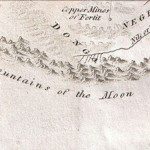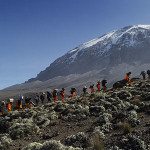Hans Meyer was the first European to reach the summit of Kili, in 1889, but he certainly wasn’t the first to try. Before his successful summit, a string of daring adventurers attempted the climb, starting with:
–
Baron Karl Claus von der Decken (1862) When Johannes Rebmann wrote of a snow-covered mountain near the equator in 1848, the only real response from the international community was derisive laughter. But some 14 years later, Baron Karl Claus von der Decken confirmed Rebmann’s sighting, and attempted a climb. He made it to about 14,000 feet before a snowstorm forced him to turn back.
Of course there could have been other reasons for his failure; the Baron reportedly worked his way through the magnum of champagne he’d intended for the summit early on, and given his reputation as a bit of a roué, it’s unlikely that was the only adult beverage he tucked away—and into—during the climb.
While he didn’t successfully summit, von der Decken’s trek finally confirmed the existence, and nature, of Kilimanjaro to the Royal Geographical Society.
 Baron Karl Claus von der Decken didn’t make it to the top of Kili, but he celebrated anyway
Baron Karl Claus von der Decken didn’t make it to the top of Kili, but he celebrated anyway
“Karl Klaus von der Decken (1833-1865)AfrikaForscher” by Unknown photographer – Photo in Familypossession. Licensed under Public Domain via Wikimedia Commons – http://commons.wikimedia.org/wiki/File:Karl_Klaus_von_der_Decken_(1833-1865)AfrikaForscher.jpg#mediaviewer/File:Karl_Klaus_von_der_Decken_(1833-1865)AfrikaForscher.jpg
–
Charles New (1871): In the Africa of the 19th century, there were two types of westerners: intrepid explorers and missionaries. New was of the latter variety, and his dedication to Kilimanjaro was as unflagging as his attempts to spread his religion (which lasted for several years, and ended in his premature death).
That dedication managed to get him to the snow line, around 14,500 feet at the time, but not to the summit. As he ascended higher and higher, his guides left him one by one, the last memorably telling New that “the ascent of this mountain is nothing to me, but I do not want you to be beaten.”
A lovely, but ultimately ineffectual, sentiment.
–
Joseph Thomson (1883): A lifelong wanderer, Joseph Thomson went on to make a name for himself as the first outsider to cross Maasailand (a journey he details quite interestingly in his book, Through Masailand).
On Kili, though, he didn’t even make it past 9,000 feet before the effects of altitude forced him to turn back “picking up at intervals [his] broken-down followers.” Apparently he’d been trying to run up as much of the mountain as he could in as short a time as possible. If only he’d had a porter to remind him to go pole, pole.
 Roguish dandy? Check. Kili? Not so much.
Roguish dandy? Check. Kili? Not so much.
“Joseph Thomson” by Unknown – [1]. Licensed under Public Domain via Wikimedia Commons – http://commons.wikimedia.org/wiki/File:Joseph_Thomson.png#mediaviewer/File:Joseph_Thomson.png
–
Count Samuel Teleki von Szek (1887): At the urging of his close personal friend, Crown Prince Rudolph (son of His Imperal Majesty Franz-Joseph I, Emperor of Austria), this Hungarian count set out to explore the lands Thomson had recently written about, accompanied by Czech naval officer Ludwig von Höhnel.
While there, the pair impulsively decided to “take in” Kili. While camping on the Saddle (between Kibo and Mawenzi), they worked their way through a good amount of red wine. That might explain why the following day, after reaching an altitude of 17,387 feet, less than 2,000 feet from the summit, Teleki von Szek decided he felt too sleepy to do anything but return to camp.
After a brief stop there for more wine, he and von Höhnel continued down the mountain.
 Live fast, explore hard
Live fast, explore hard
“Samuel Teleki”. Licensed under Public Domain via Wikimedia Commons – http://commons.wikimedia.org/wiki/File:Samuel_Teleki.jpg#mediaviewer/File:Samuel_Teleki.jpg






